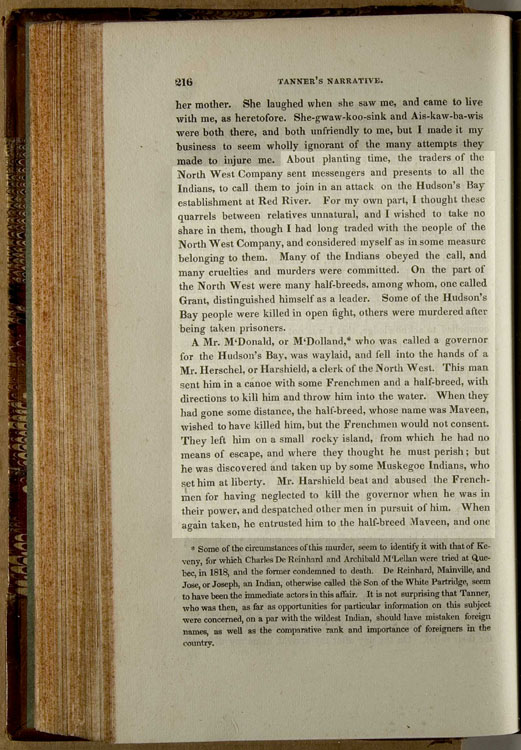
|
|
| Author: |
John Tanner, as told to Edwin James, MD |
| Title: |
Narrative of the Captivity and Adventures of John Tanner |
| Publisher: |
G&C&H Carvill, New York |
| Year Published: |
1830 |
| Copyright Holder: |
Expired; no restrictions on use. |
|
|
|
Dr. Edwin James wrote down the stories John Tanner told about his life. Tanner was kidnapped in Kentucky by Ojibwes at the age of nine and then sold to an Ottawa woman who brought him to Red River. His native name is Shaw-shaw-wabe-nase, or The Falcon.
Beginning on page 216 ["About planting time..."] and going through to page 217 ["...by so doing."], Tanner begins to speak of the hostility the NWC and its Metis servants felt towards the Selkirk Settlers and the HBC.
"...About planting time, the traders of the North West Company sent messengers and presents to all the Indians, to call them to join in an attack on the Hudson's Bay establishment at Red River. For my own part, I thought these quarrels between relatives unnatural, and I wished to take no share in them, though I had long traded with the people of the North West Company, and considered myself as in some measure belonging to them.
Many of the Indians obeyed the call, and many cruelties and murders were committed. On the part of the North West were many half-breeds, among whom, one called Grant, distinguished himself as a leader. Some of the Hudson's Bay people were killed in open fight, other were murdered after being taken prisoners.
A Mr. McDonald, or McDolland*, who was called a governor for the Hudson’s Bay, was waylaid, and fell into the hands of Mr. Herschel, or Harshield, a clerk of the North West. This man sent him in a canoe with some Frenchmen and a half-breed, with directions to kill him and throw him into the water. When they had gone some distance, the half-breed, whose name was Maveen, wished to have killed him, but the Frenchmen would not consent. They left him on a small rocky island, from which he had no means of escape, and where they thought he must perish; but he was discovered and taken up by some Muskegoe Indians, who set him at liberty.
Mr. Harshield beat and abused the Frenchmen for having neglected to kill the governor when he was in their power, and despatched other men in pursuit of him. When again taken, he entrusted him to the half-breed Maveen, and one white man, who had been a soldier, but whose well known cruelty of disposition made him fit to be chosen for such business. These two murdered him, in a manner too cruel and shameful to be particularly narrated, and then returned with the account of what they had done to Mr. Harshield.
After the settlement at Red River was reduced to ashes, and the Hudson’s Bay people driven out of the country, the Indians and half-breeds in the employ of the North West, stationed themselves at a place called Sah-gi-uk, at the outlet of Lake Winnipeg, to watch for, and destroy, any of the Hudson’s Bay people who should attempt to enter the country in that direction.
Ba-po-wash, my brother-in-law, was at length tired of starving there, and started by himself to come to our village, where I remained, refusing to take part with either side. On his way up, he met a Mr. McDolland, of the Hudson’s Bay Company, who, with Mr. Bruce for his interpreter, was going into the country. This gentleman was slow to listen to the advice of Mr. Bruce, who being better acquainted with the state of affairs in the country, had many fears on his account. On meeting Ba-po-wash, whom he well knew, Mr. Bruce, by pretending to be still in the interest of the North West, was able to gain full intelligence of all that had passed. Being convinced of the truth of this information, Mr. McDolland was persuaded to turn back and probably saved his life by so doing.”
Other
Related Material
Read more excerpts from Tanner's autobiography - enter 'Tanner' in the search box to your left.
What does John Tanner look like?
What does Cuthbert Grant look like?
Check the Beaver Index - e.g., Tanner, Grant, etc.
Who was John Tanner?
Who was this 'Grant' to whom Tanner refers?
Check your local or school library for his autobiography entitled, The Falcon.
|
Did
You Know?
The first stirrings of Métis nationalism occurred between 1812-1814 between the forks of the Assiniboine and Red Rivers. In 1812, the Selkirk Settlers began arriving in Rupert's Land, under the colonization efforts of Lord Selkirk, the major shareholder in the Hudson's Bay Company (HBC).
The NWC resented this move since settled agrarians would be detrimental to the fur and bison trades. The area was excellent bison hunting ground, and much of the pemmican produced in the region was by First Nations and Métis fur trade employees.
The Métis were enraged that Lord Selkirk brought landless and destitute colonists to the area without first consulting the territory's indigenous residents. Furthermore, the fact that he did not adequately provide them with provisions seemed shortsighted and cruel.
Unfortunately, crops failed in the first two years of settlement, and to ensure that the settlers did not starve, the HBC governor for Assiniboia, Miles Macdonnell, issued a series of edicts in 1814, known as the Pemmican Proclamations.
The first proclamation prohibited the export of pemmican, and the second tried to curb the Métis' practice of running the buffalo, which usually took the buffalo out of the territory for better hunting grounds further south.
[Préfontaine, Darren R. with Dorion, Leah. Reading #3: The Battle of Seven Oaks and the Birth of Métis Nationalism. To learn more, visit the Virtual Museum of Metis History and Culture]
|
|